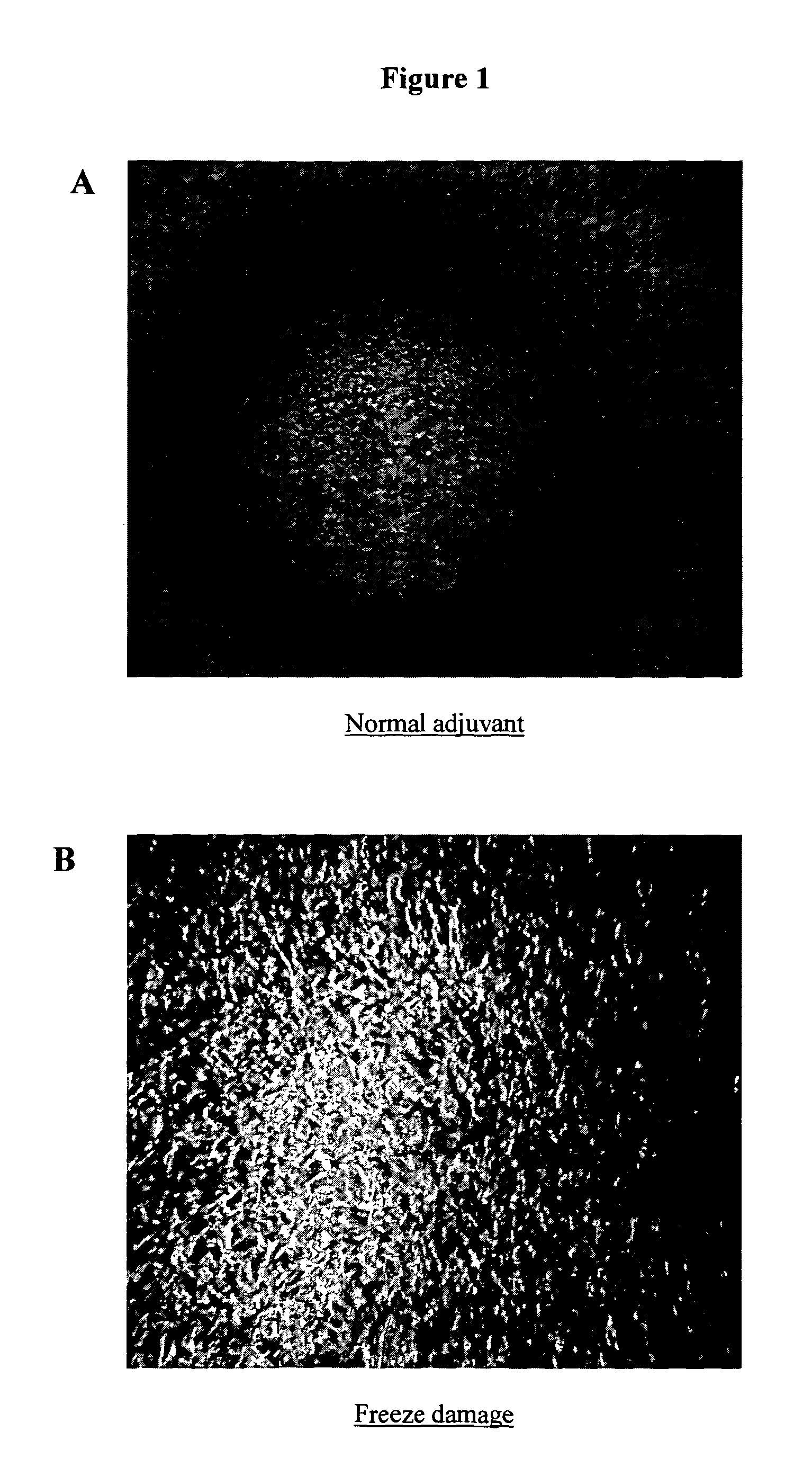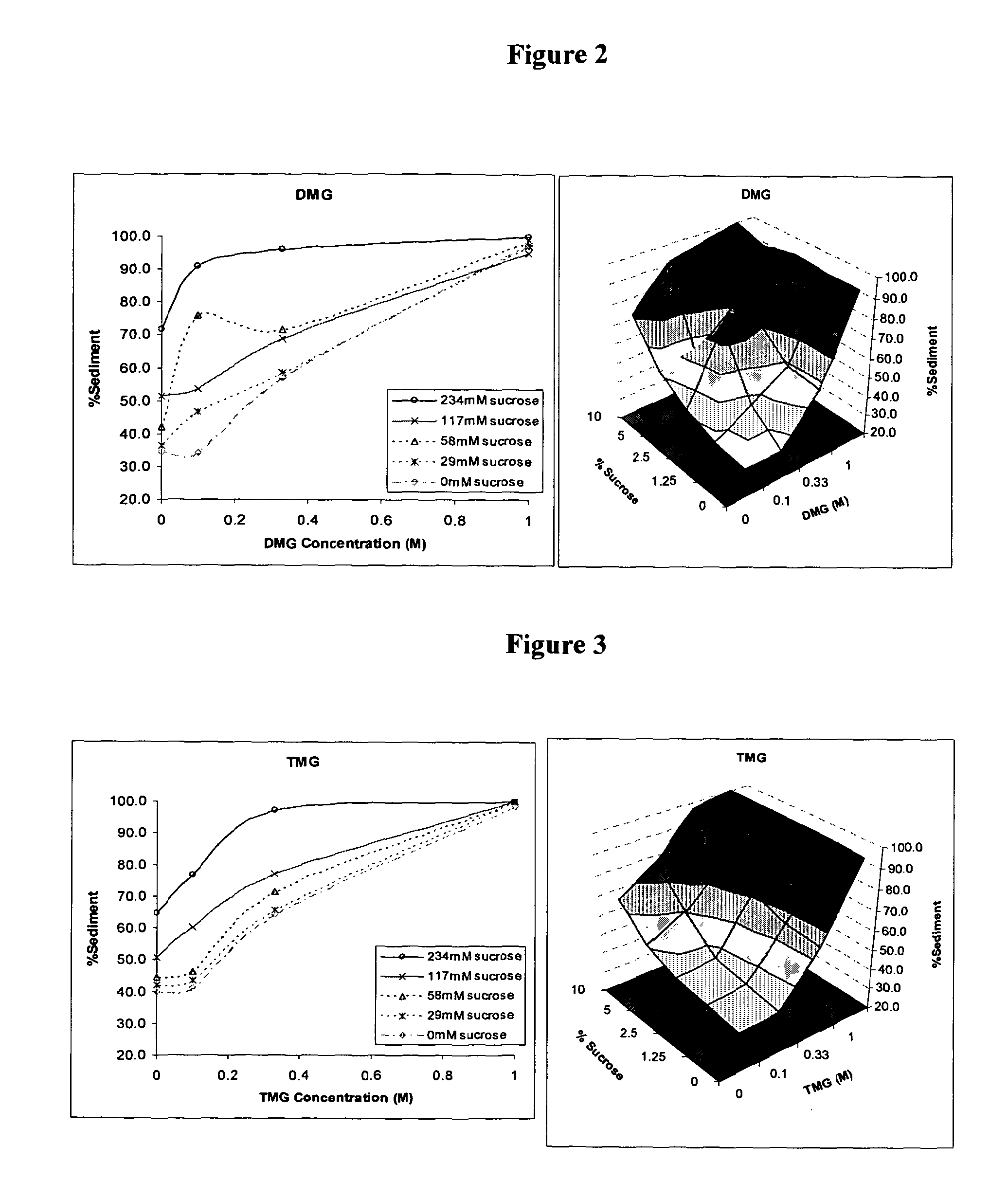Method for Preserving Alum Adjuvants and Alum-Adjuvanted Vaccines
- Summary
- Abstract
- Description
- Claims
- Application Information
AI Technical Summary
Benefits of technology
Problems solved by technology
Method used
Image
Examples
example 1
Methods
[0106]The aluminium hydroxide adjuvant was obtained from Sigma (A8222) as a 13 mg / ml solution at pH 6.8. Initially, 50 μl volumes of the aluminium hydroxide were added to 100 μl volumes of sucrose and / or a further excipient diluted in Dulbecco's phosphate buffered saline (PBS) in wells of 96 well flat bottomed microplates. The further excipient was DMG. A list of final concentrations of DMG and sucrose before freezing can be seen in Table 1 below.
[0107]The adjuvants were frozen at −20° C. After approximately 18 hours samples containing Al(OH)3 were thawed and assessed for sediment levels as described using the adjuvant agglomeration assay described below.
TABLE 1ExcipientSucroseExcipientConcentration (M)Concentration (mM)DMG1234DMG0.33234DMG0.1234DMG0234DMG1117DMG0.33117DMG0.1117DMG0117DMG158DMG0.3358DMG0.158DMG058DMG129DMG0.3329DMG0.129DMG029DMG10DMG0.330DMG0.10DMG00
Adjuvant Agglomeration Assays
[0108]The amount of agglomeration was assessed by taking up samples from each well...
example 2
Methods
[0113]The aluminium hydroxide adjuvant was obtained from Sigma (A8222) as a 13 mg / ml solution at pH 6.8. Initially, 50 μl volumes of the aluminium hydroxide adjuvant were added to 100 μl volumes of sucrose and / or a further excipient diluted in Dulbecco's phosphate buffered saline (PBS) in wells of 96 well flat bottomed microplates. The further excipients were S-methyl-L-methionine, MSM and TMG. The adjuvants were frozen at −20° C. A list of final concentrations of sucrose and the further excipient before freezing can be seen in Table 2 below.
[0114]After approximately 18 hours samples containing Al(OH)3 were thawed and assessed for sediment levels as described using the adjuvant agglomeration assay in Example 1.
TABLE 2Concentration (M)SucroseFurther excipientof further excipientconcentration (mM)S-Methyl-L-methionine1234S-Methyl-L-methionine0.33234S-Methyl-L-methionine0.1234S-Methyl-L-methionine0234S-Methyl-L-methionine1117S-Methyl-L-methionine0.33117S-Methyl-L-methionine0.111...
example 3
Methods
[0119]The aluminium hydroxide adjuvant was obtained from Sigma (A8222) as a 13 mg / ml solution at pH 6.8. A volume of adjuvant was centrifuged to form a pellet which was subsequently washed in 40 mM HEPES+25 mM NaCl at pH 7.9 (twice) and re-suspended in half the original volume, resulting in an approximately 26 mg / ml solution. Into each vial was added 75 μl of 26 mg / ml adjuvant solution and 225 μl of relevant excipient (adjusted in concentration to account for added adjuvant volume) to equal the appropriate concentration, with each vial containing a final adjuvant concentration of 6.5 mg / ml. A list of final concentrations of excipients are set out in Table 4 below.
[0120]Samples were freeze dried by the VirTis Advantage freeze dryer, using the drying cycles shown in Table 3 below, lasting for approximately 3 days. Samples were frozen at −40° C. for 2 hours before a vacuum was applied, initially at 300 milliTorre with a Thermo Savant VLP pump (Thermofisher, UK). Shelf temperatur...
PUM
| Property | Measurement | Unit |
|---|---|---|
| Molar density | aaaaa | aaaaa |
| Molar density | aaaaa | aaaaa |
| Molar density | aaaaa | aaaaa |
Abstract
Description
Claims
Application Information
 Login to View More
Login to View More - R&D
- Intellectual Property
- Life Sciences
- Materials
- Tech Scout
- Unparalleled Data Quality
- Higher Quality Content
- 60% Fewer Hallucinations
Browse by: Latest US Patents, China's latest patents, Technical Efficacy Thesaurus, Application Domain, Technology Topic, Popular Technical Reports.
© 2025 PatSnap. All rights reserved.Legal|Privacy policy|Modern Slavery Act Transparency Statement|Sitemap|About US| Contact US: help@patsnap.com



